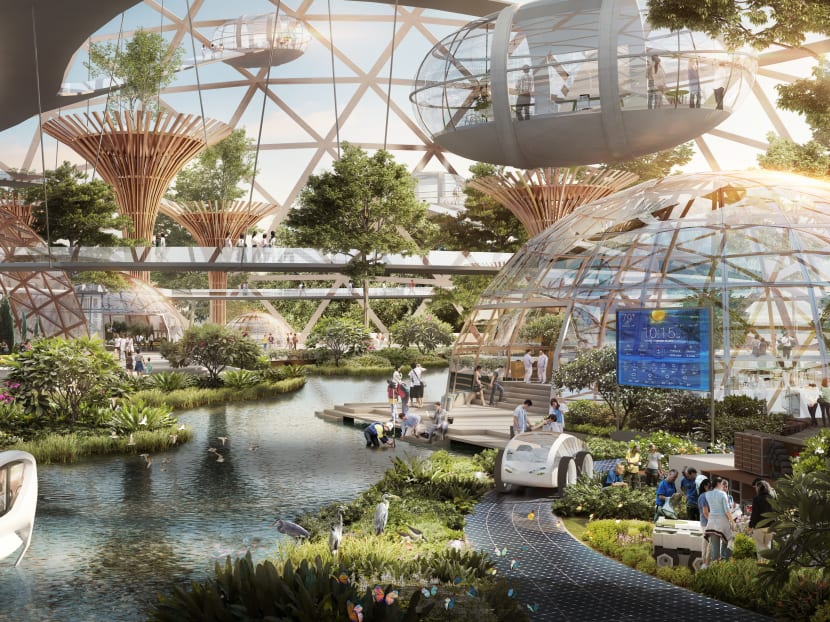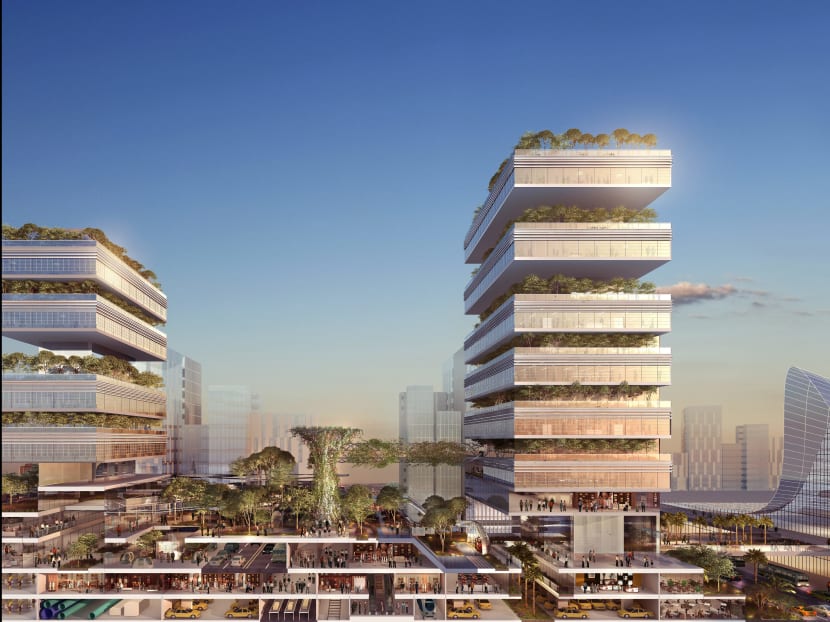Is this how S’pore's Greater Southern Waterfront will look like?
The Greater Southern Waterfront made the news recently when the Government said there were plans to expand the tourism offerings from Sentosa into the precinct, possibly making it the “Southern Gateway for Asia”. How can we design and introduce advanced urban planning concepts into this?

An artist impression of the Greater Southern Waterfront, where Singaporeans can live, work and play in a built environment that uses smart technologies, places nature first and takes a leaf out of Gardens by the Bay.
In 2013, Singapore’s Urban Redevelopment Authority (URA) announced its vision for the Republic’s southern waterfront by moving container port activities from Tanjong Pagar, Keppel, Pulau Brani and Pasir Panjang to a consolidated port in Tuas.
With highlights such as a reservoir to store storm water run-off from the greater southern waterfront, an expansion of the business district, a 30-km long waterfront promenade, and a green corridor linking Labrador Park to Gardens by the Bay, this move will mark a significant change in Singapore’s cityscape in a decade or so.
Recently, the Greater Southern Waterfront made the news again when Senior Minister of State for Trade and Industry Chee Hong Tat spoke of new government plans to expand the tourism offerings from Sentosa into the precinct, possibly making it the “Southern Gateway for Asia”.
As these redevelopment plans move closer to realisation, the public will have even more reasons for anticipation and celebrations.
For one, this is the first time residents of Singapore will be able to proudly claim to have a seafront living beyond East Coast Park and West Coast Park; spaces that have long been primarily allocated for port and airport uses.
With the southern waterfront district, there will be a new skyline for Singapore that will be visible from the Singapore Straits, giving us the unique opportunity to reshape the image of our island state.
There has already been much discussion about the business opportunities such a new district will bring.
But how can we design and introduce advanced urban planning concepts into this to further boost Singapore on the global stage?
Firstly, Sentosa, along with Pulau Brani, can become the entertainment hub of Asia, offering an expanded set of themed destinations and experiences.
An experience that is rich not only in content but also in the feel of it being situated in a lush forest setting.
Taking advantage of Singapore’s carefully nurtured reputation as a “City in a Garden”, this new entertainment and recreation district should be seamlessly connected to the Southern Ridges, running from Kent Ridge Park to Mount Faber Park, thereby extending the theme of being part of nature to the new district.
A green gateway will then welcome future visitors to Singapore arriving via the Marina Bay Cruise Center.
In addition, with land at a premium, there is immense potential for high-rise developments that introduces greenery at all levels. This allows residents and office workers to simply step out of their units to enjoy the benefits that nature brings.
One way to do so is to move motorised traffic from roads to the underground, freeing up above-ground spaces for more parks and community areas.
We could then have learning forests for school children, therapeutic gardens for the elderly, picnic areas for families and concerts in the park for music buffs.
The design of such spaces can take a leaf out of Gardens by the Bay’s Bay South Garden development. Designed with the intention to be the green anchor and lung space within the Marina Bay district, the Garden offers multiple opportunities of recreation and learning for visitors and residents alike.
Apart from the ticketed conservatories and OCBC Skyway, the public is also able to freely enjoy the botanical and cultural history of Singapore.
They can immerse themselves in the tranquil Heritage Gardens and Serene Garden, take a short walk along the picturesque boardwalks surrounding the Dragonfly & Kingfisher Lakes, or even explore tropical ecosystems in the World of Plants collection.
Imagine then having a similar Garden as part of your home and neighbourhood.

The author says new developments in the Greater Southern Gateway can feature vertically integrated projects that introduce greenery at all levels and take into consideration the underground, the above ground and the air space. Illustration courtesy of CPG Consultants
Prioritising interactions between people and nature will require changes in the way planning is done around parks and nature reserves.
This is where the concept of biophilic design – which seeks to connect or integrate natural elements and living things with the built environment – comes in.
The sustainability framework for the new district will have to be designed to keep the carbon footprint low at all stages of the development, from pre-planning to development and post-construction.
Doing so also requires Singaporeans to change our practices of wastefully using plastics, disregarding animal habitats and movement corridors, or even noise and light pollution in our daily environments.
But it would certainly help make the expansion of the Central Business District and Marina Bay into the world’s first downtown living that truly places nature first.
The technologies adopted, the processes taken and the materials used will all have to be carefully rethought to develop these new green districts.
Smart technologies can be used to create developments that are both horizontally and vertically integrated. Vertically integrated projects take into consideration the underground, the above ground and the air space.
We can have for instance, buildings that can deliver goods and services at all levels of the structure. Imagine dropping off your kids at the MRT station underground, then walking your dog in an above-ground park nearby, before hailing an air taxi to work from a rooftop.
With the future of mobility being constantly reimagined through flying cars, drones and high-speed underground systems, upcoming developments will have to be planned to accommodate such innovations that are redefining the built environment.
Infrastructures and buildings in these new districts will have to be designed to connect with each other and users seamlessly through smart technologies.
This way, users will have an enhanced understanding of spaces, both indoor and outdoor. Future residents and visitors of these districts will then be able to explore every nook and cranny of the districts with a broader understanding of what they offer.
This information can be made readily available in users’ smart phones.
It is not unimaginable that in the future, you can take your self-riding bicycle that will autonomously navigate to your favourite café, where your pre-ordered coffee is already waiting for you.
On the way back, you can pick up your pre-selected groceries from a store, already packed and paid for without you have to wait in long queues.
With careful design planning, Singapore’s Greater Southern Waterfront can be an exciting opportunity to show the rest of the world what responsible future cities look like.
Cities that respect the thresholds of our planet, respond well to climate change and foster a symbiotic relationship between man and nature.
ABOUT THE AUTHOR:
Karkal Karthik is Senior Vice President, Urban Planning Division, CPG Consultants.









